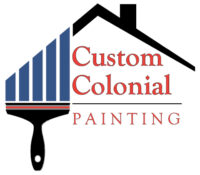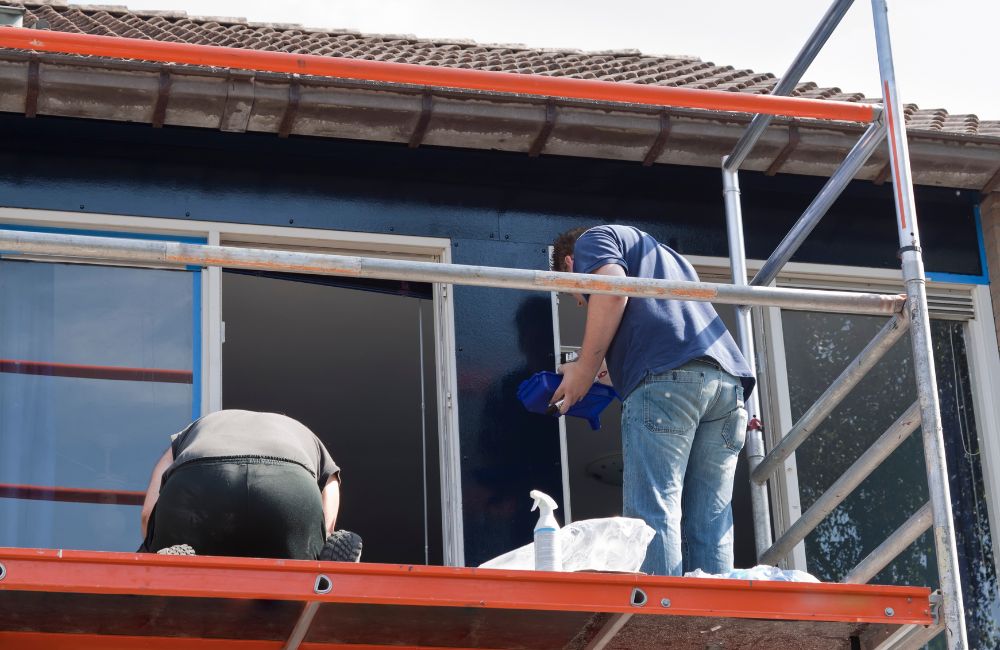Table of Contents
Key Takeaways
Introduction
8 Popular Trends in Exterior Painting
How to Choose the Right Paint
Hiring Professional Painters vs. DIY
Frequently Asked Questions
| Key Takeaways ✔ Latest trends in exterior painting for 2024, include earthy tones with vibrant pops of color to the timeless charm of vintage revival, offering homeowners diverse options to elevate curb appeal and express their unique style. ✔ Prioritize high-quality, eco-friendly options to ensure durability, longevity, and minimal environmental impact. ✔ Consider your skill level, time availability, and project complexity to make an informed decision that balances cost-effectiveness with desired results. |
As seasons shift and design preferences evolve, exterior painting constantly adapts to new trends and innovations. From vibrant color palettes that make a bold statement to timeless hues that exude sophistication, keeping up with the latest exterior painting trends can breathe new life into your home or building. To keep you in the loop, here are eight trending styles in exterior painting for the year 2024:
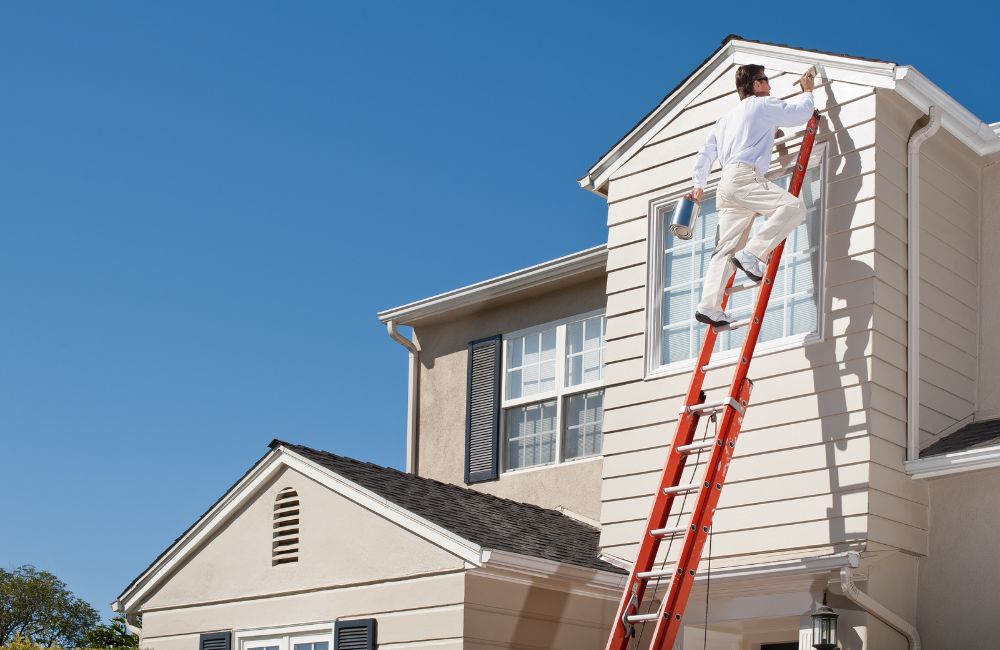
8 Popular Trends in Exterior Painting
These eight popular trends in exterior painting are transforming homes and commercial buildings in Durham, CT. Discover the latest color schemes and innovative techniques to elevate any property’s curb appeal and longevity.
1. Earth Tones with a Pop of Color
Blending earthy hues with vibrant accents creates a captivating aesthetic for exterior painting. Imagine the warmth of sandy beige walls accented with a vibrant pop of mustard yellow on the front door, or the organic charm of olive green siding paired with deep navy blue trim. Homeowners can achieve a harmonious balance that exudes sophistication and personality by incorporating earthy tones as the foundation and infusing bold pops of color strategically.
Popular Color Combinations in this Trend
- Terracotta with Turquoise: The warmth of terracotta walls is beautifully complemented by the cool, refreshing hue of turquoise accents, which creates a dynamic contrast that instantly draws the eye.
- Olive Green with Burnt Orange: The earthy richness of olive green siding paired with burnt orange trim evokes a sense of autumnal splendor, adding warmth and character to any exterior.
- Sandy Beige with Coral: Soft sandy beige is a neutral backdrop for vibrant coral accents, infusing the exterior with lively energy and tropical flair.
- Warm Gray with Mustard Yellow: A sophisticated combination of warm gray siding and mustard yellow accents for exterior painting strikes the perfect balance between modern elegance and playful charm.
2. Matte Finishes
Matte finishes have surged in popularity for exterior surfaces due to their understated elegance and contemporary appeal. Unlike glossy finishes, which reflect light and highlight imperfections, matte finishes offer a smooth, velvety texture that adds a touch of sophistication to any exterior. They create a subtle, non-reflective surface that showcases color depth and architectural details without highlighting flaws.
Benefits of Matte Finishes
- Timeless Aesthetic: Matte finishes lend a timeless elegance to exterior surfaces, creating a sophisticated backdrop for any architectural style.
- Conceals Imperfections: Matte finishes are excellent at hiding surface imperfections such as scratches, dents, and uneven textures, resulting in a flawless appearance.
- Modern Appeal: Matte finishes exude a contemporary vibe that aligns with current design trends, making them popular for homeowners seeking a fresh and stylish exterior look.
- Low Maintenance: Matte finishes are relatively low maintenance compared to glossy finishes. They are less prone to dirt, fingerprints, and water spots, keeping your exterior looking pristine with minimal effort.
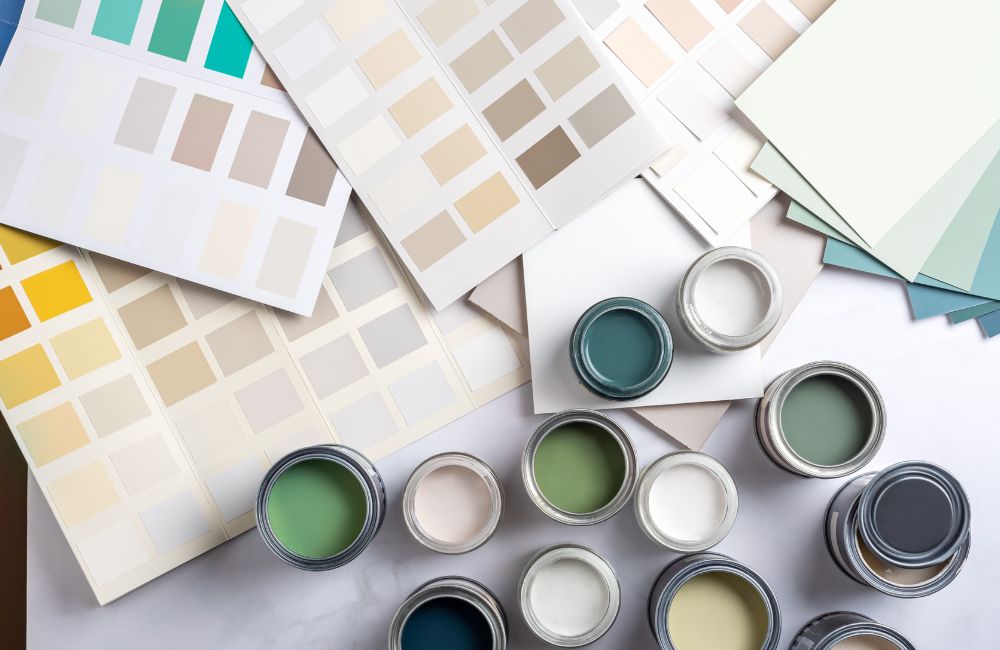
3. Nature-Inspired Palettes
Nature-inspired palettes for exterior painting draw upon the serene beauty of the natural world, infusing homes with a sense of harmony and tranquility. These palettes often feature soft, muted tones reminiscent of earth, sky, and foliage, creating a seamless connection between the built environment and its natural surroundings.
Examples of Soothing Nature-Inspired Color Schemes
- Sky Blue and Cloud White: Inspired by the vast expanse of the sky, this exterior painting color combination features a soft blue hue reminiscent of a clear summer day. It is paired with crisp white trim to create a fresh and airy feel.
- Leafy Green and Sandy Taupe: Reflecting the lush foliage and the warmth of sun-drenched sand, this palette combines verdant green siding with sandy taupe accents, creating a natural and inviting ambiance.
- Stone Gray and Moss Green: Inspired by the rugged beauty of stone formations and moss-covered rocks, this color scheme pairs a cool gray backdrop with rich moss-green trim.
- Sunset Orange and Goldenrod Yellow: Inspired by the warmth and vibrancy of a sunset, this palette features hues of orange and yellow reminiscent of golden hour, infusing the exterior with warmth and energy.
4. Dark and Dramatic
Making a bold statement with dark and dramatic colors adds a sense of sophistication and drama to exterior painting projects. These hues command attention and create a striking visual impact, making a bold statement while showcasing the home’s architectural features whether used as a primary or accent, dark and dramatic colors add depth, contrast, and personality to any exterior.
Tips for Incorporating Dark Colors Into Exterior Painting Projects
- Balance with Lighter Tones: Pair dark colors with lighter tones or white trim to prevent the exterior from feeling too heavy or imposing. This creates a sense of balance and contrast that enhances the overall aesthetic.
- Strategic Placement: Use dark colors in exterior painting strategically to highlight architectural features or focal points, such as entryways, shutters, or accent walls. This draws the eye and adds visual interest without overwhelming the entire façade.
- Consider Surroundings: When choosing dark colors, consider the surrounding landscape, climate, and architectural style. Dark hues for exterior painting may absorb more heat in sunny climates and may not be suitable for homes in hot regions.
5. Two-Tone Siding
The trend towards two-tone siding offers homeowners a creative way to add visual interest and depth to their exteriors. By using contrasting colors for the upper and lower portions of the home, or for different architectural features, homeowners can create a dynamic and eye-catching façade. This trend allows for endless possibilities in customization, allowing homeowners to express their unique style while enhancing curb appeal.
Effective Two-Tone Siding Combinations
- Dark and Light Contrast: Pairing a dark color like charcoal gray or navy blue with a lighter shade such as crisp white or soft beige in exterior painting creates a striking contrast. The dark color can be used on the lower portion of the home or as an accent, while the lighter color brightens up the upper levels.
- Warm and Cool Tones: Combining warm and cool tones in exterior painting, such as earthy browns with soothing blues or greens, creates a harmonious balance that evokes a sense of comfort and serenity. This combination is especially effective for homes nestled in natural settings, blending seamlessly with the surrounding landscape.
- Color Blocking: Opting for bold color-blocking techniques in exterior painting, such as alternating vertical stripes or geometric patterns, adds a modern and playful twist to the two-tone siding. This approach allows homeowners to experiment with unconventional color combinations and create a unique exterior that stands out from the crowd.
- Traditional Elegance: For a more classic and refined look, consider pairing neutral tones, such as taupe or beige, with a deep, rich color like burgundy or forest green. This timeless combination for exterior painting exudes elegance and sophistication, making it ideal for traditional or historic homes.
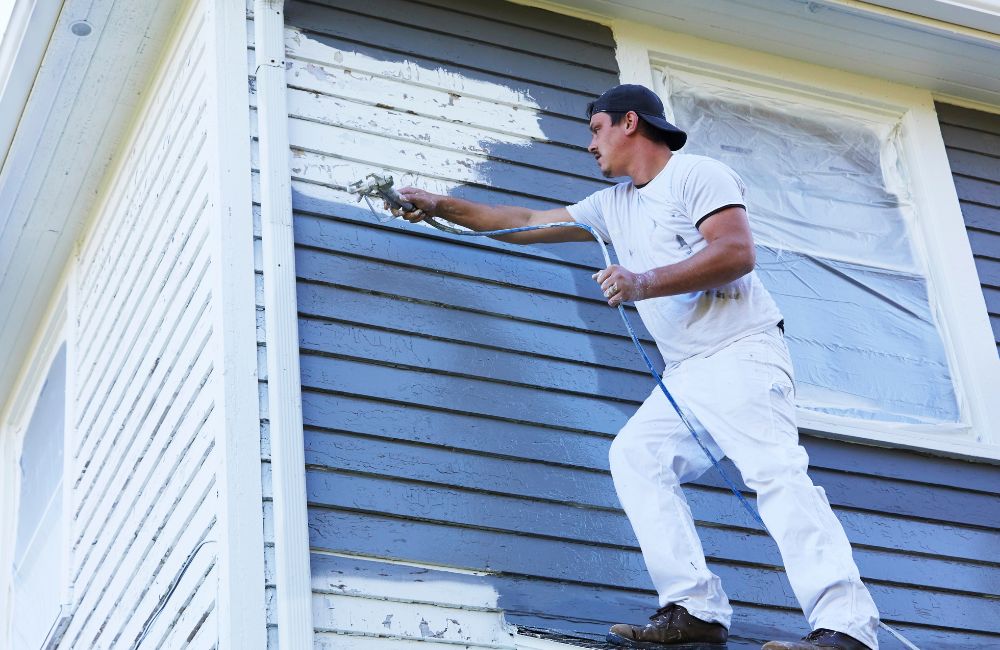
6. Metallic and Black Accents
Incorporating metallic and black accents into exterior designs adds a touch of luxury and sophistication, elevating the home’s overall aesthetic. These stylish accents create visual interest and contrast against neutral backgrounds, which draws attention to architectural features and enhances curb appeal. From sleek black trim to shimmering metallic accents, these design elements add a sense of glamor and refinement to any exterior.
Tips for Incorporating Metallic and Black Accents
- Focus on Key Features: Choose architectural elements such as doors, windows, trim, and decorative accents to highlight with metallic or black finishes.
- Consider the Overall Aesthetic: Take into account the architectural style and color palette of the home when selecting metallic and black accents. Choose finishes that complement the existing design elements and enhance the overall aesthetic, rather than detracting from it.
- Mix and Match: Don’t be afraid to mix different metallic finishes, such as brushed nickel, bronze, or copper, to add depth and dimension to the exterior. Similarly, experiment with combining black accents with metallic finishes for a modern and eclectic look.
- Keep it Cohesive: While it’s important to add visual interest with metallic and black accents, strive for cohesiveness and balance in the overall design. Avoid overdoing it with too many contrasting elements, and instead, focus on creating a harmonious composition that enhances the beauty of the home.
7. Sustainable Choices
The growing interest in eco-friendly painting options reflects a broader trend towards sustainability and environmental responsibility. Homeowners are increasingly seeking paint products that minimize harm to the environment while providing high-quality results.
Sustainable Paint Choices
- Low-VOC Paints: Traditional paints release harmful VOCs into the air during application and drying, contributing to indoor and outdoor air pollution and posing health risks to occupants. Low-VOC paints contain significantly lower levels of these chemicals, making them safer for both human health and the environment.
- Recycled Paint: Recycled paint is made from leftover paint collected from households, businesses, and recycling centers, which is then processed and reblended into new paint products. Additionally, recycled paint often comes in a variety of colors and finishes, offering homeowners an eco-friendly and cost-effective alternative to traditional paint products.
- Biodegradable Primers: Primers are essential for promoting adhesion and durability in exterior paint applications, but many conventional primers contain harsh chemicals that can harm the environment. Biodegradable primers are made from natural ingredients that break down safely over time, reducing the risk of pollution and harm to ecosystems.
8. Vintage Revival
The resurgence of vintage-inspired color palettes in exterior painting reflects a nostalgia for simpler times and a desire to reconnect with the past. Vintage colors evoke a sense of nostalgia and charm, harkening back to bygone eras of classic Americana and traditional craftsmanship. From soft pastels to rich jewel tones, vintage-inspired color palettes for exterior painting add warmth, character, and timeless appeal to any exterior.
Examples of Classic Color Combinations
- Soft Pastels: Soft pastel colors like blush pink, mint green, and powder blue bring a sweet, old-fashioned charm. They add a playful and romantic touch to any building’s exterior. These delicate shades create a sense of tranquility and serenity, inviting homeowners to slow down and savor the simple pleasures of life.
- Rich Jewel Tones: Deep, rich jewel tones like ruby red, sapphire blue, and emerald green exude elegance and sophistication. These bold colors make a statement while adding depth and drama to the exterior, creating a sense of luxury and refinement that never goes out of style.
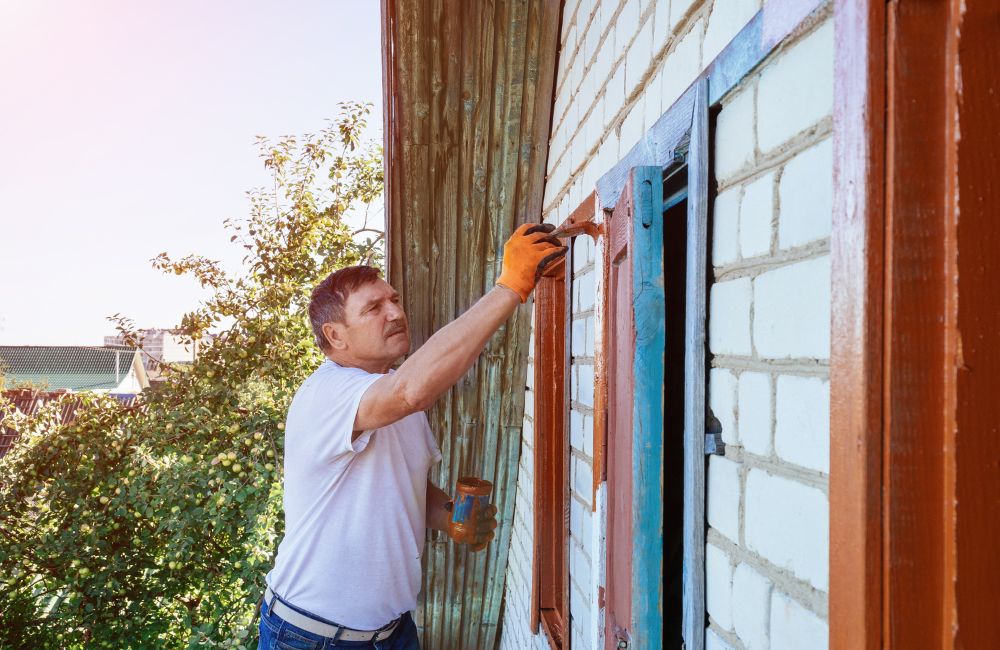
How to Choose the Right Paint
Selecting the right type of paint is crucial for achieving a durable and long-lasting finish on your home’s exterior. Consider the following factors when choosing paint for your project:
Exterior Paint Types
There are several types of exterior paint to choose from, including latex/acrylic, oil-based, and water-based paints. Latex/acrylic paints are popular for their ease of application, fast drying time, and durability. Oil-based paints offer superior adhesion and durability but require longer drying times and proper ventilation during application. Water-based paints are environmentally friendly and offer quick drying times, but may not be as durable as oil-based options.
Sheet
Exterior paints come in various sheens, including flat, satin, semi-gloss, and high-gloss. The sheen you choose will impact the appearance and performance of your paint job. Flat finishes are ideal for concealing surface imperfections but may be less resistant to stains and damage. Satin and semi-gloss finishes offer a subtle shine and are easier to clean, making them suitable for high-traffic areas like doors and trim. High-gloss finishes provide maximum durability and shine but may accentuate surface flaws.
Color Selection
When selecting paint colors for your exterior, consider factors such as architectural style, landscape surroundings, and personal preference. Lighter colors can make a home appear larger and more inviting, while darker colors add drama and sophistication. Be sure to test paint samples on your home’s exterior under different lighting conditions to ensure the desired effect.
Quality
Investing in high-quality paint is essential for achieving professional results and ensuring long-term durability. Look for paints that are specifically formulated for exterior use and feature features such as UV resistance, mold and mildew resistance, and fade resistance. While premium paints may come with a higher price tag, they often offer superior coverage, color retention, and longevity.
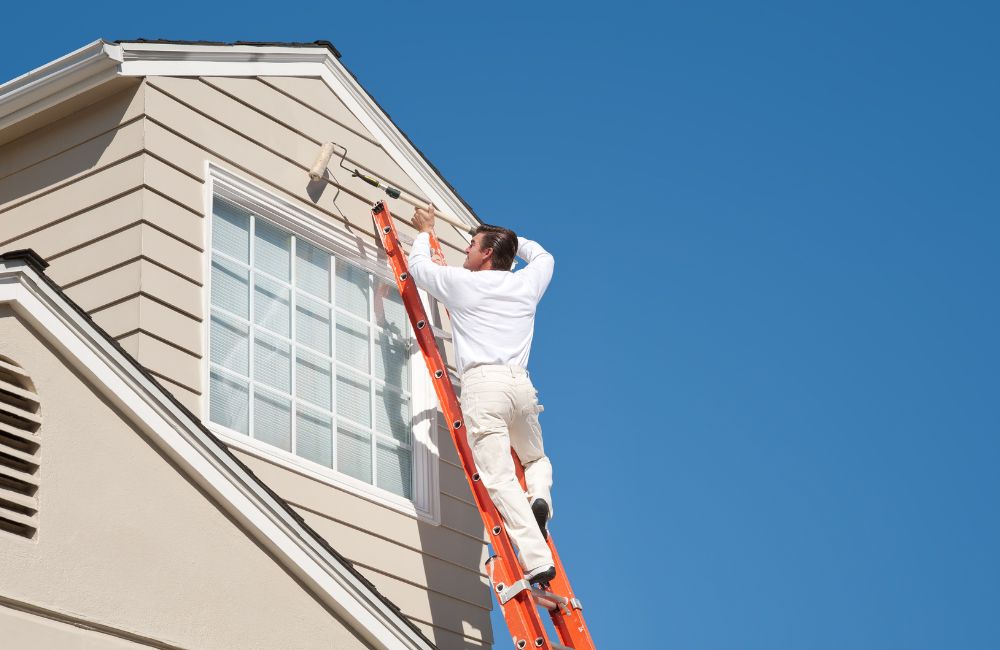
Hiring Professional Painters vs. DIY
Deciding whether to tackle your exterior painting project yourself or hire professional painters depends on various factors, including your skills, time, budget, and the complexity of the job. Here are some considerations for both options:
DIY Painting
- Cost: DIY painting can be more cost-effective than hiring professionals, as you’ll save on labor costs.
- Flexibility: Painting your home yourself allows you to work at your own pace and make decisions about colors, finishes, and techniques.
- Learning Experience: DIY painting can be a rewarding learning experience, providing you with new skills and knowledge about home improvement.
- Time Commitment: Exterior painting is a time-consuming task, requiring careful preparation, application, and cleanup. Be prepared to invest significant time and effort into your project, especially if you’re tackling it alone or for the first time.
- Skill Level: Consider your level of experience and comfort with painting techniques, as well as your ability to safely work at heights if your home has multiple stories.
Hiring Professional Painters
- Expertise: Professional painters like Custom Colonial Painting in Durham, CT, have the skills, experience, and equipment necessary to achieve professional-quality results efficiently and effectively.
- Time Savings: Hiring professionals can save you time and hassle, as they’ll handle all aspects of the painting process, from preparation to cleanup.
- Quality Assurance: Professional painters use high-quality materials and techniques to ensure a flawless finish that withstands the elements and the test of time.
- Safety: Exterior painting can be hazardous, especially when working at heights or using ladders and scaffolding. Professional painters are trained in safety protocols and have the necessary equipment to work safely.
- Warranty: Many professional painting companies offer warranties or guarantees on their workmanship, providing added peace of mind and assurance of quality.
Frequently Asked Questions
Why is exterior painting important?
Exterior painting plays a crucial role in maintaining the overall appearance and integrity of a home. Beyond simply enhancing curb appeal, it serves as a protective barrier against the elements, shielding the exterior surfaces from damage caused by weather, moisture, and UV radiation..
Can exterior paint be used indoors?
Using exterior paint indoors is generally not recommended due to its formulation. Exterior paints contain additives designed to withstand weather conditions and may release higher levels of volatile organic compounds (VOCs) than interior paints, potentially affecting indoor air quality. It’s best to use paints specifically formulated for indoor environments to ensure safety and optimal performance.
When should exterior painting be done?
Ideally, exterior painting should be done during mild weather conditions when temperatures are moderate, and there is minimal precipitation. Typically, spring and fall are considered the best seasons for exterior painting, as they offer moderate temperatures and lower humidity levels, creating optimal conditions for paint application and drying. Painting during extreme heat or cold, as well as during periods of high humidity or heavy rain, can compromise the quality and durability of the paint job.
How long is exterior paint good for?
Generally, high-quality exterior paints applied to properly prepared surfaces can last anywhere from five to ten years or more before needing repainting. However, certain factors such as harsh weather conditions, direct sunlight, and high levels of moisture can accelerate paint deterioration and necessitate more frequent repainting.
What to do before exterior painting?
Thorough preparation is essential before starting an exterior painting project. Begin by cleaning the surfaces to remove dirt and contaminants, then address any imperfections like cracks or peeling paint. After that, sand the surfaces for a smooth finish and apply a high-quality primer to promote adhesion.
Elevate Your Home’s Curb Appeal with Custom Colonial Painting!
Revitalize your home’s exterior and make a lasting impression with Custom Colonial Painting’s expert exterior painting services! Stay ahead of the curve with the latest trends in color palettes, finishes, and techniques tailored to enhance your home’s unique style and personality. Whether you want to refresh your current look or embark on a complete transformation, our skilled team is here to bring your vision to life. Elevate your curb appeal and create a stunning first impression – schedule your consultation with Custom Colonial Painting in Durham, CT, today!
